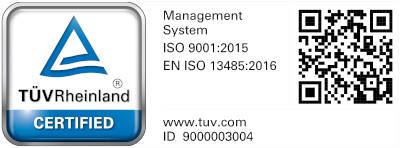Tendonitis: what it is and how to treat it with ultrasounds
Generally, tendonitis is identified as a pain at the junction area between the muscle and bone, regardless of the level at which the pain occurs.
In fact, there are several types of tendinitis. The common denominator is inflammation of the tendon structure, which can occur at the junction of tendon and muscle, or at the bone insertion. Other times the inflammation affects the sheath of the tendon, which prevents it from sliding properly.
In the face of this inflammatory state, the preferred treatment is functional offloading-in other words, rest.
However, instrumental therapies are an effective way of intervention too, with the aim of speeding up the recovery and reducing the inflammation, as well as pain.
Within this framework, ultrasound therapy plays an important role in the treatment of tendinitis both in chronic and sub-acute phase (i.e., when the acute phase of inflammation subsides while still causing pain).
What is meant by tendonitis?
As you might have guessed from the introduction, tendonitis is an inflammatory state of the tendons.
Tendons join muscle and bone; therefore, they have the function of transmitting movement. Unlike muscles, tendons are not extensible, so they are subject to greater mechanical stress, particularly in the areas where they join muscle and bone.
You have probably already heard of the “tennis elbow,” one of the most well-known forms of tendonitis (epicondylitis).
This is a very common condition among tennis players, who, during the game, greatly overload the forearm area (not to mention the traumatic component related to the impact of the racket with the ball). Epicondylitis, basically, affects all those individuals who for many hours a day perform repetitive movement of t h e hand and forearm.
Another very common type of tendonitis, especially among those who participate in running activities or activities with high acceleration or deceleration, such as volleyball, tennis, and paddle, is at the Achilles tendon. Inflamed Achilles tendon very often originates from the friction of the shoe with the tendon, and can be particularly disabling since this structure, once inflamed, is also stressed outside of sporting activity.
What types of tendonitis exist?
Tendinitis can be of various nature: traumatic, micro-traumatic, or stress-related.
The main difference between these types lies in the recovery time: a traumatic tendonitis will have a successful resolution in a shorter time, while a stress tendonitis will take longer (particularly if you do not have the possibility to avoid or limit the activity that caused it).
The areas of the body most affected by tendonitis are:
– shoulder,
– elbow,
– hand,
– knee,
– ankle.

Tendonitis: symptoms
The primary symptom of tendonitis is local pain. This is aggravated by pressure on the tendon itself or the area of origin at the muscle or bone level (in the insertional zone).
In more advanced stages, when the inflammatory component is very important, there is also an increase in local temperature, as well as possible skin redness and edema.
In these cases, pain persists even in absence of stress, with a particular upsurge in the early morning hours after overnight immobility.
The causes of tendonitis
As mentioned earlier, tendonitis can be caused primarily by major mechanical stresses, such as the results of a fall or sprain, or by direct trauma, as well as by functional overloads.
Many sports people suffer from this condition; indeed, some disciplines expose the tendons to repeated stress, particularly when resuming activity after long periods of stop or greatly intensifying training.
Some examples?
– Tennis promotes the onset of elbow tendinitis such as epicondylitis or epitrochleitis,
– Jump sports such as volleyball and basketball expose knees and ankles to tendonitis,
– running sports, often due to unsuitable footwear, cause tendonitis in the foot and ankle. These inflammations, however, are not only due to sports practice.
Activities that might seem “less impactful” can overstress the tendons and generate inflammatory states, such as: playing the piano or guitar (hand/elbow tendonitis), riding a motorcycle or bike after winter break (forearm, elbow, finger tendonitis).
Certainly, to limit risk, good prevention turns out to be an excellent strategy. However, early intervention in treating the condition also makes a difference.
Ultrasounds, precisely, also plays an important role in the early stage of tendonitis: it limits the aggravation of symptoms and promotes faster recovery.
This prevents the problem from developing more violently, forcing the person to stop the activity that caused it.
How to treat tendonitis? Therapies and remedies
The treatment of tendonitis involves, as a first action, functional rest. Limiting gestures or activities that may feed it is recommended.
This clearly does not apply to tendinitis of traumatic origin.
In the inception stages, as well as in chronic stages, ultrasound therapy is an excellent solution being practical and, to date, easily used at home.
The only caution is not to use it immediately in case the inflammatory state is in the acute stage, so as not to increase the perception of pain in an uncomfortable way.
This temporary increase in pain can also occur in the treatment of chronic stages, but it is transient and part of the healing process.

Tendonitis: ultrasound therapy or laser therapy?
The laser is a high-end professional tool that needs great expertise to be used correctly. The advantage of the laser over ultrasound is that it can be used even in the acute phase, thus, when pain is at its worst, acting effectively on the very pain.
Ultrasound on the other hand, given its mechanical nature, works best in the incipient stages of disease onset, in the subacute or chronic phase. So, when the pain is less burning and acute, leading to an effective endogenous response.
In addition, ultrasounds can also be used on one’s own, preferably behind specific physician’s directions, while the laser must necessarily be used by a professional.
Tendonitis and ultrasound: the trick of the "reactive crisis"
Ultrasound acts on the tendon by creating a mechanical stress that actually makes the affected structures believe they have a higher level of pain, and therefore stress, than they really do.
This occurs due to the stresses of the ultrasonic waves.
In this way, you are able to enhance the endogenous, physiological response, speeding up the healing process.
The effect that is generated is known as a “reactive crisis.”
This mechanism in the acute phase can be uncomfortable since, the level of inflammation and pain is particularly important. At this stage, therefore, it is best to stop the triggering movement for a few days and then begin ultrasound treatments.
It is good to be aware that there may be an increase in symptoms in the first few days of treatment and that the greatest benefits are obtained once the cycle of sessions, which is about 10, is completed.
If you are wondering how many minutes of ultrasound a day to do, know that each session can last 5-10-15 minutes. Short sessions for fast results!
The duration of the treatment, in fact, ranges from 5 to 15-20 minutes depending on the issue. Five minutes may be sufficient to treat a contracture or as support for pre-race warm-up of a specific area. To treat tendon or joint problems, on the other hand, it is necessary to protract the treatment for 15-20 minutes in order to create sufficient local stimulation suitable to trigger an appropriate reactive crisis.
When not to do ultrasounds
Ultrasounds are not recommended in the acute phases of both traumatic and stress-related diseases, thus, when the pain level is high or an increase in local temperature is evident, which are indications of a major acute inflammatory state.
Exercises for tendonitis
In the acute phase, movement is not a good way to reduce a tendonitis since the strain on the tendon can easily increase its inflammatory state.
Conversely, in the chronic phase, movements involving the muscle related to the sore tendon can promote a reduction in inflammation by increasing vascularization. In this phase, movements should be performed either without load or with minimal loads, with the sole purpose of performing the correct movement to promote sliding of the tendon in its sheath.
The activity that can be carefully performed in the acute phase is stretching. This can reduce the basal tension of the muscle, thereby also decreasing the mechanical stress on the tendon affected by the pathology.
Stretching should be performed progressively without increasing pain during its execution in order not to trigger rapid chronicity of pain.
We always recommend that you seek professional advice before trying your hand at exercises that may, if done incorrectly, not help the inflammatory condition.
Ultrasound therapy at home
Ultrasound, therefore, is an excellent tool for timely intervention
on the occurrence of tendonitis, regardless of the body district affected.
An easy-to-use and portable tool is the most logical choice so that you can intervene on your own as early as you begin to notice the first symptoms.
With a fixed frequency, also suitable for being deeply effective, and intensity adjustable in three levels, Powersonic is an ideal medical device for the treatment of conditions such as tendonitis, proving to be an ideal tool for athletes as well.

Our customer service is available to answer your questions and guide you in choosing and using the device in order to best meet your needs






